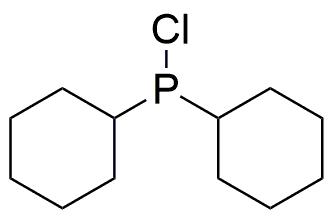Chlorodicyclohexylphosphine is widely utilized in research focused on:
- Organophosphorus Chemistry: This compound serves as a key reagent in synthesizing various organophosphorus compounds, which are important in developing agrochemicals and pharmaceuticals.
- Catalysis: It acts as a ligand in catalytic processes, enhancing the efficiency of reactions in the production of fine chemicals and specialty materials.
- Material Science: Used in the modification of polymers, it improves the properties of materials, making them more suitable for applications in coatings and adhesives.
- Pharmaceutical Development: Its unique structure allows for the design of novel drug candidates, particularly in targeting specific biological pathways.
- Research in Coordination Chemistry: The compound is valuable in studying metal complexes, contributing to advancements in fields like bioinorganic chemistry and materials science.
General Information
Properties
Safety and Regulations
Applications
Chlorodicyclohexylphosphine is widely utilized in research focused on:
- Organophosphorus Chemistry: This compound serves as a key reagent in synthesizing various organophosphorus compounds, which are important in developing agrochemicals and pharmaceuticals.
- Catalysis: It acts as a ligand in catalytic processes, enhancing the efficiency of reactions in the production of fine chemicals and specialty materials.
- Material Science: Used in the modification of polymers, it improves the properties of materials, making them more suitable for applications in coatings and adhesives.
- Pharmaceutical Development: Its unique structure allows for the design of novel drug candidates, particularly in targeting specific biological pathways.
- Research in Coordination Chemistry: The compound is valuable in studying metal complexes, contributing to advancements in fields like bioinorganic chemistry and materials science.
Documents
Safety Data Sheets (SDS)
The SDS provides comprehensive safety information on handling, storage, and disposal of the product.
Product Specification (PS)
The PS provides a comprehensive breakdown of the product’s properties, including chemical composition, physical state, purity, and storage requirements. It also details acceptable quality ranges and the product's intended applications.
Certificates of Analysis (COA)
Search for Certificates of Analysis (COA) by entering the products Lot Number. Lot and Batch Numbers can be found on a product’s label following the words ‘Lot’ or ‘Batch’.
*Catalog Number
*Lot Number
Certificates Of Origin (COO)
This COO confirms the country where the product was manufactured, and also details the materials and components used in it and whether it is derived from natural, synthetic, or other specific sources. This certificate may be required for customs, trade, and regulatory compliance.
*Catalog Number
*Lot Number
Safety Data Sheets (SDS)
The SDS provides comprehensive safety information on handling, storage, and disposal of the product.
DownloadProduct Specification (PS)
The PS provides a comprehensive breakdown of the product’s properties, including chemical composition, physical state, purity, and storage requirements. It also details acceptable quality ranges and the product's intended applications.
DownloadCertificates of Analysis (COA)
Search for Certificates of Analysis (COA) by entering the products Lot Number. Lot and Batch Numbers can be found on a product’s label following the words ‘Lot’ or ‘Batch’.
*Catalog Number
*Lot Number
Certificates Of Origin (COO)
This COO confirms the country where the product was manufactured, and also details the materials and components used in it and whether it is derived from natural, synthetic, or other specific sources. This certificate may be required for customs, trade, and regulatory compliance.


